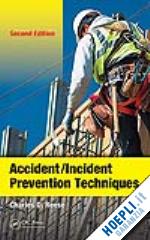IntroductionWhy Injury Prevention?Accidents or IncidentsAccident/Incident Prevention ProcessComprehensive Accident PreventionAccident PreventionAccident Prevention BenefitsPreventing Occupational Accidents/IncidentsNothing New in PreventionHow Much Prevention?Risk ControlStructuring Accident/Incident PreventionKnow Who You Are Dealing WithDetermining the Cause of AccidentsAccident Prevention TechniquesReferencesSafety and Health ProgramsIntroductionReasons for a Comprehensive Safety ProgramSafety and Health Management ProcessBuilding a Safety and Health ProgramCharacteristics of an Occupational Safety and Health ProgramTools for a Safety and Health Program AssessmentAssessing the Key Components of Leadership, Participation, and Line AccountabilityAssessing the Key Components of Worksite AnalysisAssessing the Key Components of Hazard Prevention and ControlSummaryReferencesAccident/Incident InvestigationIntroductionPurpose of Accident InvestigationsAccident PreventionReporting AccidentsOrganizing and Assigning ResponsibilitiesSupervisors and Accident InvestigationInvestigations Benefit the SupervisorPreplanning an Accident InvestigationInvestigation ProcessHandling the EvidenceDeveloping Accident Investigation FormsFinal Report of InvestigationFollow-UpSummaryReferencesHazard Recognition and AvoidanceHazard IdentificationEmphasis on HazardsAccident CausesHazard AnalysisWorksite Hazard AnalysisTraining on Hazard IdentificationWorksite Hazard IdentificationRanking HazardsHazard and Cost AvoidanceHazard ControlTechniques of Hazard ControlSummaryReferencesAccountability and ResponsibilityIntroductionThe Safety and Health ProfessionalThe Line Supervisor.Using the Supervisor Evaluation FormThe Worker86References.88Motivating Safety and HealthIntroduction1Planning the Motivational ApproachSupervisorsSelf-Motivated WorkersChanging BehaviorBehavior-Based SafetyFactors Affecting MotivationSafety CultureVisual MotivatorsNonfinancial IncentivesSummaryReferences0Accident/Incident AnalysisIntroductionBreakdown of CausesMishap ProbabilitySummaryReferencesRoot Cause AnalysisIntroductionPhase I: Data CollectionPhase II: AssessmentPhase III: Corrective ActionsPhase IV: InformPhase V: Follow-UpSummaryReferencesCausal Factor AnalysisIntroductionDefinitionDetermining Causal FactorsEvent Factor Chains (Charting) and ExplanationBenefits of Events and Causal Factors ChartingUsing Causal Factor Analysis (Event Factor Chains or Charting)Causal Factor WorksheetSummaryReferencesChange AnalysisIntroductionWhen to Use Change AnalysisHow to Use Change AnalysisStructuring the AnalysisSummaryReferencesBarrier AnalysisIntroductionPhysical Barrier AnalysisHuman Barrier AnalysisWrap-Up of Preliminary Data AnalysisInterpretation of PBA and HBAReferencesJob Safety/Hazard AnalysisIntroductionPerforming a JSA/JHAFour Basic Steps of a JSA/JHASelecting a Job to AnalyzeThe Job Safety/Hazard Analysis WorksheetSeparating the Job into Its Basic StepsSequence of Basic Job StepsIdentifying the Hazards Associated with Each Job StepConsider Human Problems in the JSA/JHA Process 186Eliminating or Controlling the HazardsChange Job ProceduresChange the Frequency of Performing the JobPersonal Protective EquipmentSummaryReferencesSafe Operating Procedures (SOPs)IntroductionComponents of an SOPGuidelines for Writing an SOPHow SOPs WorkSummaryReferencesJob Safety ObservationIntroductionPurpose of Job Safety ObservationTypes of Job Safety ObservationsSelecting a Job or Task for a Planned Job Safety ObservationPreparing for a Planned Safety ObservationChecklist of Activities to ObserveUnsafe ProceduresThe ObservationAfter the ObservationDealing with Unsafe Behaviors or Poor PerformanceSummaryReferencesSafety and Health AuditsIntroductionThe Need for an AuditWhen to AuditWhat to AuditTypes of Audit InstrumentsDevelop and Evaluate Audit ScoresQualifications of AuditorsSummaryReferencesFleet Safety ProgramIntroductionWritten Fleet Safety ProgramVehicle/Equipment MaintenanceRegulations and Motor VehiclesDriversOperator Recruitment and SelectionRecords to MaintainOperator TrainingCompany Operator’s ManualPre-Operation InspectionDriving TasksSafe Driving RecognitionPlanning Schedules, Loads, and RoutesPreventing AccidentsReferencesPreventive Maintenance ProgramsIntroductionComponents of a PMPPreventive MaintenanceManagement’s RoleThe Preventive Maintenance Program (PMP)Operators’ InspectionsMaintenanceManagement ResponsibilitySummaryReferencesSpecial Emphasis ProgramsIntroductionLadder Safety ProgramIncentivesSummaryReferencesUsing Safety and Health ConsultantsIntroductionNeed for a ConsultantConducting the InterviewScope of WorkFinal Hiring StepsSummaryReferencesSafety and Health TrainingIntroductionWhen to TrainTraining New HiresTraining SupervisorsTraining EmployeesDocumenting Safety and Health TrainingAfter the TrainingSafety TalksSafety Talks and MeetingsOSHA Training RequirementsOSHA Training GuidelinesLegal Aspect of TrainingOSHA Training ModelMatching Training to EmployeesIdentifying Employees at RiskTraining Employees at RiskSummaryReferences6Analyzing Accident DataIntroductionOSHA RecordkeepingCompany RecordsImportant Ancillary Data Needed for More Complete AnalysisStatistical Analysis for ComparisonsWorkers’ CompensationCost of AccidentsSummaryReferencesPrevention and OSHA RegulationsIntroductionFederal Laws.309Regulation ProcessFederal RegisterThe Purpose of OSHACode of Federal RegulationsCFR Numbering SystemOSHA Standards CoveredCopies of the OSHA StandardsRelief (Variance) from an OSHA StandardOSHAct ProtectsThe Role of the National Institute for Occupational Safety and Health (NIOSH)The Role of the Occupational Safety and Health Review Commission (OSHRC)Employers are Responsible for Workers’ Safety and HealthWorkers’ RightsWorkers’ Responsibilities under the LawThe Right Not to Be Discriminated AgainstThe Right to KnowEnvironmental Monitoring ResultsPersonal Protective ClothingOSHA InspectionsOSHA Receives a ComplaintCitationsTypes of ViolationsChallenging Citations, Penalties, and Other Enforcement MeasuresWorkers Get the Results of an InspectionDetermining PenaltiesState ProgramsWorkers’ TrainingOccupational Injuries and IllnessesMedical and Exposure RecordsPostingWhat to Do When OSHA Comes KnockingSummaryReferencesHealth Hazard PreventionIntroductionAsbestosBack InjuriesBloodborne PathogensCarcinogensCold StressErgonomicsHazardous ChemicalsHazardous WasteHeat StressIonizing RadiationLasersLeadNoise-Induced Hearing LossNonionizing RadiationVibrationWorkplace StressReferencesControls and Personal Protective EquipmentIntroductionControlling HazardsPersonal Protective EquipmentEstablishing a PPE ProgramHazard AssessmentEye and Face ProtectionHead ProtectionFoot and Leg ProtectionHand and Arm ProtectionBody ProtectionHearing ProtectionRespiratory ProtectionSummaryReferencesSafety HazardsIntroductionAbrasive Blasting (29 CFR 1910.94 and 1910.244)Abrasive Wheel Equipment/Grinders (29 CFR 1910.212, 1910.215, and 1910.243)Air Receivers (29 CFR 1910.169)Aisles and Passageways (29 CFR 1910.17, 1910.22, and 1910.176)Belt Sanding Machines (29 CFR 1910.213)Chains, Cables, Ropes, and Hooks (29 CFR 1910.179 and 1910.180)Compressors and Compressed Air (29 CFR 1910.242)Compressed Gas Cylinders (29 CFR 1910.101 and 1910.253)Compressed Gases (29 CFR 1910.101, 1910.102, 1910.103, 1910.104, 1910.106, and 1910.253)Confined Spaces (29 CFR 1910.146)Containers and Portable Tank Storage (29 CFR 1910.106)Control of Hazardous Energy Sources [Lockout/Tagout] (29 CFR 1910.147)Crane, Derrick, and Hoist Safety (29 CFR 1910.179, 1910.180, and 1910.181)Dip Tanks Containing Flammable or Combustible Liquid (29 CFR 1910.108)Dockboards (29 CFR 1910.30)Drinking Water (29 CFR 1910.141)Electrical (29 CFR 1910.303, 1910.304, 1910.305, 1910.331, and 1910.333)Elevated Surfaces (29 CFR 1910.23)Emergency Action Plans (29 CFR 1910.38)Exit Doors (29 CFR 1910.36)Exits and Exit Routes (29 CFR 1910.36)Explosives and Blasting Agents (29 CFR 1910.10











